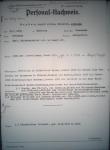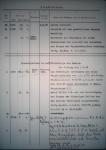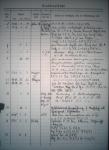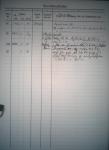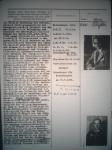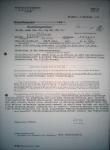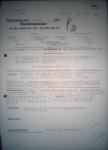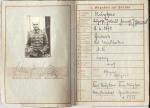-
Posts
4,908 -
Joined
-
Last visited
-
Days Won
97
Content Type
Profiles
Forums
Blogs
Gallery
Events
Store
Everything posted by Dave Danner
-
Closest match I can find is Oberwachtmeister Prange of the Großhergoglich Landesgendarmerie. He was granted permission to accept the Königlich Dänische silberne Belohnungsmedaille mit Krone, AKA den Kongelige Belønningsmedalje i Sølv med Krone, AKA the Royal Medal of Recompense in Silver with Crown, on 28 May 1913. He also had the Iron Cross 2nd Class, Mecklenburg-Schwerin Military Merit Cross 2nd Class, and Mecklenburg-Schwerin Military Service Cross. But he also had the Mecklenburg-Schwerin Verdienstmedaille, which normally came on a blue ribbon. Maybe someone knows if it was awarded on another ribbon which might match what is otherwise a second long service cross? Otherwise, close but no cigar.
-
Hello and welcome to the forum. I assume you are only asking about Prussian decorations. Prussian soldiers could also sometimes earn medals from other states of the German Empire and foreign countries, although they were less likely to get them than officers. Yes, the medals of the Red Eagle and Crown Orders could be awarded to active soldiers, although these were not common. To your list, you could also add the Lifesaving Medal (Rettungsmedaille am Bande) and the Red Cross Medal (Rote Kreuzmedaille). There were also awards in peacetime of the different classes of the General Honor Decoration (Allgemeines Ehrenzeichen) to NCOs and soldiers. Regards
-
Rick and British Intelligence are correct. Divisions-Fernsprech-Abteilung Nr. 449 would have been formed in the 49.Reserve-Division after the December 1916 reorganization of signals troops. "Abteilung" here means detachment. They weren't battalion-sized, but more like a reinforced company. They were formed from the division's existing Fernsprech-Doppelzug, which was so named because it included two platoons, one for operators and one for line-layers. After 10 April 1917, they also included the Division-Blinkertrupp as a third platoon. Chris Boonzaier has an article about signals troops which discusses their organization here . He says they had a Stationszug and 3 Fernsprechzüge for a strength of 11 officers and 350 men, so I assume they must have been further reorganized. The proper abbreviation is Divferna or Div.-Ferna, so Rick is probably right that the "Diferna" bar was custom made.
-
One of his relatives constructed a family tree at an online genealogy site. I suppose we can thank the Mormons. Mormon missionaries have been collecting birth, christening, marriage and death records all over Europe, which has allowed for creating more detailed family trees than might otherwise have been available with one's own family records.
-
Some additional information about his family, in case you're interested: Karl Nuyken was born on 9 April 1854 in Burgsteinfurt. Anna Schwollmann was born on 4 February 1862. Karl and Anna were married on 13 August 1885. They had five sons: • Triss, born on 27 August 1886 in Biebrich am Rhein • Karl, born on 25 December 1888 in Biebrich am Rhein • Hans, born on 8 June 1890 in Biebrich am Rhein • Otto, born on 26 October 1898 in Münster in Westfalen • Wessel, born on 22 March 1900 in Münster in Westfalen Perhaps being the middle one of five brothers accounts in part for his comradely demeanor. Karl Nuyken spent his career in the Prussian public works administration, mainly in water supply matters. A Regierungs-Bauführer in Münster, he was named a Regierungs-Baumeister in 1884. In 1893, he was named Königlich Meliorations-Bauinspektor there. In 1901, he was transferred to Breslau and named a Regierungs- und Baurat. In 1902, he was transferred to the Ministerium für Landwirtschaft, Domänen und Forsten in Berlin. These moves show up in Hans Nuyken's personnel file above, under "Erziehung". In 1904, Karl Nuyken was named a Geheimer Baurat und Vortragender Rat in the ministry in Berlin, and in 1908, he was a Geheimer Oberbaurat. He retired as a Ministerialrat in 1921. He was an Oberleutnant der Landwehr a.D., and had served in the reserve and Landwehr of IR 55 in the 1880s. The 1908/09 Deutsche Ordens-Almanach shows Karl Nuyken with the Red Eagle Order 4th Class, Crown Order 3rd Class, and Landwehr-DA 2nd Class. This was already out of date, as his Red Eagle was bumped to an RAO3 with Bow in December 1908. The Crown Order 2nd Class followed in January 1912, and the RAO3S was replaced by the Red Eagle Order 2nd Class with Oakleaves in July 1918. The 1918 Prussian Court and State Handbook also shows that he received the Prussian Merit Cross for War Aid. His medals might have ended up somewhere, but as two separate neck orders and a nondescript two-medal bar with PrVfK and LD2, were probably broken up.
-
One caveat: There was a Kgl. Bayer. Oberstabsarzt d.R. a.D. Dr. Friedrich Schmidt. Born on 29.1.1861 in Friedberg in Oberbayern, he was a practicing doctor and Kgl. Hofrat in Augsburg. The Kriegsrangliste of the Reserve-Lazarett Augsburg A identifies him as a "Laz. u. Dienstthuender San.-Offz. b. Bez. Kdo." and says he was transferred on 31.5.16 to the Kriegslazarett-Abteilung of the 6. bayer. Reserve-Division. Unfortunately, this Kriegsrangliste gives no other details of his military career and I cannot find him in any other Kriegsrangliste. There is a Kriegsrangliste u. -stammrolle for a Kriegslaz.-Abt. attached to the 6.b.RD, but he does not appear in the name index. The 1919 entry in the Bavarian Verordnungsblatt for the BMV4XKr identifies the recipient as Oberstabsarzt "Dr. Friedrich Schmidt der Reserve (Augsburg)". Given the aforementioned OSAdRaD Schmidt's Augsburg connection, it is quite possible that he, not the Marine-OSAdR, is the recipient of the BMV4XKr.
-
Terberger entered the Army as a Musketier in IR 55 on 13 May 1896, so he would have gotten the Centenary. Also, as a combat commander with seventeen years of service in IR 55 before his transfer to IR 158 (which was despite its name also a Westphalian regiment), he was probably a lock for a Lippe Kriegsverdienstkreuz.
-
OK, here's a bit of a mystery. In the 1908/09 Deutscher Ordens-Almanach, Bernhard v. Ditfurth is shown with the awards above, but also with the 1866 Ehrenkreuz. Based on the Stammliste extract Rick provided, Ditfurth entered IR 28 eleven days after the regiment fought at Königgrätz, he would likely have had an Ehrenkreuz für Treuen Krieger. However, Ditfurth's entry in the 1904/05 Deutscher Ordens-Almanach does not have the 1866 Ehrenkreuz. So we are left to wonder, what's the deal? Was this medal bar made after 1897 when he added the Red Eagle and the Centenary? And for some reason, he added the 1866 Ehrenkreuz after 1905 to his entitlements, but did not bother to add it to his medal bar? I imagine he may have felt that while he may have been technically entitled to the Ehrenkreuz, he wasn't comfortable wearing it, since he probably spent the 1866 campaign in a recruit depot. Given his WW1 assignment, there's a good chance he added at least an Allgemeines Ehrenzeichen "Für Kriegsverdienst", but perhaps at his age felt no more need to monkey around with medal bars. From what I've seen, more than a few older WW1 veterans never updated their pre-war medal bars, and instead wore wartime medals from the buttonhole or the like.
-
Joining the Army and going into combat aren't the same thing. From his Wehrmacht file, Helmuth v. Bülow, born on 25.6.1899, entered active duty as a Fahnenjunker in DR 16 on 28.9.15, so just three months after his 16th birthday. Gefreiter on 9.11.15, Unteroffizier on 27.1.16, and simultaneously Fähnrich and Leutnant on 5.9.17 with effect from 5.11.17. But his campaign participation list only shows actions in 1917 and 1918, so it seems the regiment did not send him to the front until he was almost or at least 18. Richard Abé, born 17.6.1898, was a Kriegsfreiwilliger on 17.2.15, four months shy of 17. But he did not enter combat until 7.10.15, so 17 years and 4 months. Kurt Krappe, born 15.7.1899, was a Kriegsfreiwilliger in the 1.Ers.-MGK VIII.Armeekorps on 30.11.15. He went to the front on 6.5.16 with LIR 73. So he was still 16, albeit just two months shy of 17.
-
Nice! Thank you for posting. One correction: Paul Theodor Alfred Wilhelm Emmery v. Lorck was born in 1866, not 1855. He received the Fürstlich Schwarzburgisches Ehrenkreuz 2. Klasse mit Eichenbruch "1914/15" on 31 October 1916 from Schwarzburg-Rudolstadt. Is there a medal bar out there somewhere? I would guess that ribbon #3 is the Fürstlich Reußisches Ehrenkreuz 2. Klasse am Kriegsbande from Reuß jüngere Linie (Reuß-Gera). That would match with the Schwarzburg award as the appropriate award for homefront merit for an officer of his rank. Unfortunately, there is no surviving military awards roll from Reuß j.L. and the "civilian" award roll I have only includes a handful of military awards, typically to reservists whose award recommendations came from their civilian employer rather than their military unit.
-
Of the others, most appear to be Hannoverians. I don't see Friedrich Karl Ernst Poten, but there were at least three other Potens in the Hannoverian Army in 1866, not including Karl August Wilhelm, who went into the Prussian Army (UR 5, DR 16, HR 4), so it's likely he was also Hannoverian. There are too many Meyers to sort. For the others, here are their last Hannoverian Stellungen and where they went in the Saxon Army. Basse, Julius Wilhelm General d. Inf. (1848-1934) • 9.7.66 SecLt., Kgl. hannov. Leib-Regt. • Kgl. sächs. 8.Inf.-Regt. Boddien, Georg Albert Rittmeister d. R. a. D (1850- • 12.8.66 SecLt., Kgl. hannov. Garde-Regt. • Kgl. sächs. 1.Ulan.-Regt. Brinkmann, Julius Erich Eberhard Oberst (1823-1903 ) • Brinckmann • 13.6.59 Hptm., Kgl. hannov. 5.Inf.-Regt. • Kgl. sächs. 4.Inf.-Regt. Decken, Theodor von der Major a. D (1842- • 18.6.66 PremLt, Kgl. hannov. Garde-Husaren-Regt. • Kgl. sächs. 1.Ulan.-Regt. Decken, Eberhardt Wilhelm Benedikt von der Oberst a. D. (1843- • 26.6.66 PremLt., Kgl. hannov. Garde-Regt. • Kgl. sächs. 8.Inf.-Regt. Ebmeier, Georg William Premier-Lieutenant (1844- • 19.5.65 SecLt, Kgl. hannov. Art.-Brig. • Kgl. sächs. Feldart.-Regt. Harling, Maximilian Friedrich Major (1832- • 16.10.56 PremLt, Kgl. hannov. Art.-Brig. • Rittm., Kgl. sächs. 3.Reit.-Regt. Hodenberg, Gottlob Frhr von Oberst (1837- • 9.5.59 Kgl. hannov. PremLt.i.G. • Kgl. sächs. 2.Gren.-Regt. Klenck, Wilhelm Fritz Carl Rittmeister • 9.5.61 PremLt., Kgl. hannov. Königin-Hus.-Regt. • Kgl. sächs. 2.Reit.-Regt. Köring, Ernst Friedrich Gustav Major (1839- • 17.6.60 SecLt., Kgl. hannov. 3.Inf.-Regt. • PremLt., Kgl. sächs. 5.Inf.-Regt. Poten, Karl August Wilhelm Major (1845-1905) • 17.11.64 SecLt., Kgl. hannov. Regt. Hzg. v. Cambridge Dragoner • Kgl. sächs. 1.Reit.-Regt. Schele, Arnold Ludwig Hauptmann • Freiherr v. Schele (5.7.1849-21.8.1922) (http://de.wikipedia.org/wiki/Arnold_von_Schele) • 2.8.66 SecLt., Kgl. hannov. Garde-Regt. • Kgl. sächs. 2.Gren.-Regt. Tschirschnitz, Julius Oswald Oberst (1834-1921) • 28.5.64 Kgl. hannov. Hptm.i.G. • Kgl. sächs. Leib-Gren.-Regt. Uslar-Gleichen, Ludolf Frhr von Major (1842- • 21.5.66 PremLt., Kgl. hannov. 1.Jäg.-Btl. • Kgl. sächs. 1.Jäg.-Btl.
-
Kgl. Sächs. Generalmajor z.D. Hans Gottlob August v. Bülow was born on 23.7.1836 in Göttingen as the son of Kgl. hannov. Rittm. Otto Wilhelm Friedrich Joachim Karl v. Bülow (1795-1872), and died in Schwerin in Mecklenburg on 6.4.1896. According to the 1896 Saxon rank list, he also had the Albert Order, Commander 1st Class. He was an ex-Hannoverian officer, and shows up in the 1867 rank list as a Hauptmann in the Festungs-Artillerie-Regiment with a Patent of 13.3.1867. He was prior to that a Premierlieutenant in the Kgl. hannov. Generalstab. with a date of rank 18.5.1857.
-
So I have been trying to identify an officer from IR 91 named "v. Bülow", which is almost as bad as being named "Schmidt" for ease of searching Imperial records. He is in the Ehrenrangliste among recalled inactive officers as an OLt.a.D. "v. Bülow, Wilhelm (IR 91)". A first name should make it easy, right? Unfortunately, there were 9 military-age Wilhelms, especially considering we have no idea when he was actually in IR 91 so you can't limit yourself to 20-somethings. The problem I had was, no Wilhelm v. Bülow is identified in Gotha as being in IR 91 except for Wilhelm Heinrich Georg Karl Berthold v. Bülow, who was already an active Hauptmann in IR 91 and Major a.D. in the Ehrenrangliste. And I couldn't find another v. Bülow in IR 91. The (partial) answer to this mystery, and why it is in this thread? He was actually a Lt. in IR 24 for most of his short career. He was commissioned on 18.8.08 and was with that regiment until 19.11.12, when he was transferred to IR 91. He only appears in IR 91 in the 1913 rank list. And in the 1914 rank list: I still have no idea why he was "otherwise separated", when he was recalled, where he served during World War I, or when he was promoted to Oberleutnant a.D. (I suspect it was a "Charakter" promotion in 1921). I also can't say for certain which Wilhelm v. Bülow he was, although I am 99% sure that he was Gustav Albrecht Georg Wilhelm v. Bülow, born on 7 May 1885. He is of the right age to be a Lt. in 1908 and in Gotha he was listed as a "Lt." with no unit given. He is in a late 1916 Verlustliste as "vermißt", again with no unit given, and in a 1917 Verlustliste as "bish. vermißt, i. Gefgsch.". So there may be an interesting story with this Wilhelm, but I have no idea how one would find out any more.
-
OK, I saved the image in the last post and compared it to what I uploaded; The image I chose for attachment was: • Dimensions: 1350 x 947 pixels • Resolution: 360 dpi • File size: 408 kB The attachment seems to have become: • Dimensions: 1141 x 800 pixels • Resolution: 96 dpi • File size: 154 kB So not only is it smaller, it has lost a good deal of resolution.
-
I posted essentially the same answer as Rick last night, but for some reason it didn't post. I'm not sure about the numbering. From inages I have saved from various auctions, I see: Lt.d.L. Richard Wernecke. His SEK3X document was numbered "228". But his award was one of several on the 31 January 1917 awards list which were the 456th through 469th awards of the SEK3X by Schwarzburg-Sondershausen. Lt.d.R. Hans Nothnagel. His SEK3X document was numbered "627". But his award was on 15 March 1917, in the next awards list after Wernecke's (Nrs. 471-499).



